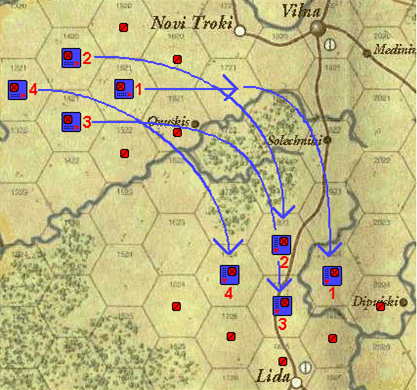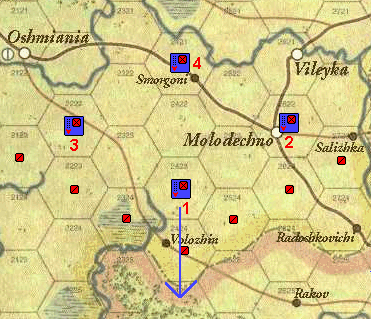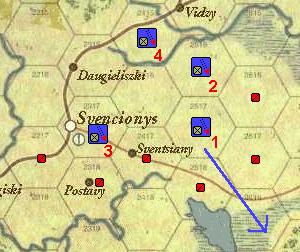|
|
|
The Napoleonic system of corps manoeuvres
There are plenty of books, articles and other expositions of the bataillon carré system perfected by Napoleon, particularly in the campaigns of 1805-9. Rather than repeating what has gone before, this article only attempts to reconcile the reality to a wargame hex-grid strategic movement system.
The examples below use the map used for the NHWC 1812 campaign, with a scale of 16km per hex. At that scale, one day's march for an infantry corps is between 1 and 2 hexes. This is the first thing to be borne in mind when deciding how a number of corps will operate in mutual support - the whole purpose of the bataillon carré system. This gives the player/commander an immediate maximum spread for his corps: no more than two hexes apart. Any corps further than that from its fellows will not be able to give or receive support and must be treated as an independent command, either strong enough to take care of itself or in a safe enough place to not have to worry about.
 |
The first
example shows an army of four corps, advancing east towards Vilna and then south towards Lida. The interval
between corps in this instance is a safe, mutually supportive, single hex, allowing at least two corps
to go to the assistance of another, with the farthest away being within one hard
day's march or two days' at the most. The cavalry screen laid out in front consists of four regiments, which can
be expected to be well within the capacity of the three leading corps' cavalry
contingents. On being ordered to change their direction of advance, south towards Lida, 3rd Corps, being the southernmost, takes over the lead on the new heading. The cavalry of 4th Corps are deployed to screen that part of the new frontage. 2nd Corps' cavalry has been withdrawn, though it could be used on either flank, and this corps now acts as the reserve. One quirk of the hex grid system is that it now seems to need five cavalry regiments to cover the front of the formation, though as few as two could do the job as a thinner screen. |
The
second example depicts the same four corps at the maximum safe spacing of
two hexes - a long day's march or two days if the passing of messages and
time to come into action are included. Although a much wider front could
be covered, this open spacing would be when still at a considerable distance from the
enemy and concentration would be made increasingly as closer contact was
made. The wider frontage requires more light cavalry in the screen, in this case seven regiments for complete coverage, with a minimum of three for lighter patrolling. So an effective screen might need some light cavalry to be detached from the cavalry reserve to act with one or more of the army corps. |
 |
 |
The final example shows the army moving in a
south-easterly direction and in a less regular formation. The left flank is
reinforced - en potence - with three corps in close support of each
other, while the right flank is more extended but with a cavalry screen to
the flank as well as front. |
Finally, a word about 'marching to the sound of the guns'. This is a phrase often seen in
wargame campaign orders, but sometimes without consideration of how far off
gunfire might be heard. On the day of Waterloo, Wellington's forces at Hal,
about 15km from the battlefield, heard nothing of it whereas Grouchy, a similar
distance in the opposite direction, could hear it clearly.
On the above campaign map scale of 16km per hex, only forces in adjacent
hexes have a reasonable chance of hearing gunfire. Even if those further away do hear
it, they have little chance of getting to the battlefield much before the end of
the following day.